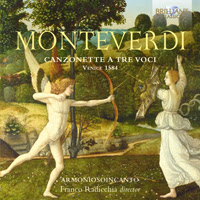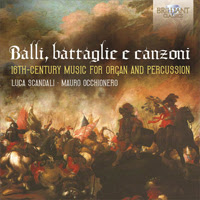Program: #17-08 Air Date: Feb 13, 2017
To listen to this show, you must first LOG IN. If you have already logged in, but you are still seeing this message, please SUBSCRIBE or UPGRADE your subscriber level today.
A Vespers for St. Barbara, music for organ and percussion, and the first of many new releases for the Monteverdi 450th.
I. Franzoni: Vespro per la Festa di Santa Barbara (Accademia degli Invaghiti/Concerto Palatino/Francesco Moi). Brilliant Classics CD 95344.

The scene is Mantua in Lombardy, Italy. The Duke of Mantua – himself a composer and eager to become a patron of the arts ¬– establishes a Basilica in the city. Freed from the auspices of Rome and with its own bespoke liturgy, the Basilica became the focus of a thriving musical environment. It was at this point that Franzoni, Maestro di Cappella at the Basilica, was commissioned to write the Vespro per la Festa di Santa Barbara for the grandest ceremony of the year, celebrating the life of the martyr to whom the Basilica was dedicated.
Taking inspiration from his surroundings and the Basilica itself, where the piece was to be performed, Franzoni wrote suitably grandiose music for the occasion. Employing the use of highly skilled trumpet and cornet players, and writing intricate passages of complexity for the large chorus available to him, Franzoni worked closely with the acoustics of the venue by carefully placing musicians around the space. The occasion also required novel use of instruments; solo passages are interspersed with vocal passages, and instruments double vocal lines – practices born out of necessity that would soon become commonplace.
The work is performed by leading period ensembles; the Accademia degli Invaghiti – named after the original 16th-century Mantuan group – is joined by period cornetto and trombone ensemble Concerto Palatino, led by Bruce Dickey and Charles Toet. Supported by the Cappella S. Barbara, together they draw on their in-depth knowledge of Franzoni's work to authentically position the performers and produce the sense of occasion Franzoni intended.
The court of the Gonzaga family in Mantua occupies an unique and distinguished position in 16th and 17th century Italy both for the quality and quantity of musical activity associated with it and its palatine basilica of Santa Barbara. With the construction of Santa Barbara, Duke Guglielmo Gonzaga succeeded in endowing the city with a monumental palatine basilica and its own autonomous liturgy. Equally important was the formation of the cappella musicale: Guglielmo recruited the finest vocalists and instrumentalists available and promoted the composition of cyclical masses, magnificats, and motets based on melodies drawn from the liturgy of the palatine basilica.
The present recording project focuses on the music of Amante Franzoni (1575-1630), Maestro di Cappella of the St Barbara Basilica. His Vespers for Santa Barbara include 4-, 5- and 6-part, as well as polychoral Psalms. Short instrumental interludes are included between the choral works.
1
Entrata
2
Versus: Deus in adiutorium. Responsorium. Domine ad adiuvandum
3
Antiphona: Angelicam vitam
4
Psalmus: Dixit dominus
5
Canzon francese “la Gonzaga”
6
Antiphona: In dei orto sata
7
Psalmus: Laudate pueri
8
Canzon a Quattro
9
Antiphona: Paterni oblita amoris
10
Psalmus: Laetatus sum
11
Concerto, psalmus: Laudemus dominum, Two Sinfonie a otto
12
Antiphona: In sancte trinitatis
13
Psalmus: Nisi dominus
14
Antiphona: Trinitate venerate
15
Concerto
16
Psalmus: Lauda Jerusalem
17
Duo Seraphim
18
Sonata sopra Sancta Maria
19
Capitulum: Confitebor
20
Hymnus: Exultet celebres virginis
21
Responsorium: Ora pro nobis
22
Antifona: Hodie Beata Barbara
23
Sinfonia
24
Magnificat
25
Oratio et conclusion
II. Balli, battaglie e canzoni—16th Century Music for Organ & Percussion (Luca Sandali/Mauro Occhionero). Brilliant Classics CD 95384.
Presenting a rare collection of pieces from the earliest days of the Italian Baroque keyboard school, this is an exciting and unusual release from Brilliant Classics. Featuring the period’s leading composers and virtuosi of the organ (Cristofano Malvezzi and Giovanni Maria Trabaci were both employed as organists by the Italian nobility) this release contains some significant early collections of works for keyboard – Intavolatura de cimbalo has some of the earliest offerings from the Naples school, and the Manoscritto di Castell’Arquato is one of the most important collections of Italian keyboard music from the first half of the 16th century. The selected works also contain numerous musical forms that would later evolve into the widespread popular dance forms of the Baroque period, such as the toccata and the fugue. These early forms include the elaborate and technically demanding Recercada and the stately Ballo, of which Marco Cavazzoni and Giovanni Picchi offer fine examples.
Experts in the musical heritage of their respective instruments, Luca Scandali and Mauro Occhionero bring their dedication to period performance to this distinctive blend of early instruments. Occhionero demonstrates his skills on an array of traditional percussion, including the Neapolitan tammorra, the darbuka and the djembe, all revealing Italy’s important position, at a cultural crossroads in the Mediterranean. Luca Scandali plays an original late-16th-century organ in the Church of Santo Stefano in Lucca, Italy, built by master organ maker Onofrio Zeffirini. With 30 years of research activity acting as the basis for this recording, the listener is guaranteed an exciting and historically-grounded musical experience.
A unique project: the combination of church organ and percussion instruments performing early Italian keyboard music!
The early keyboard music manuscripts not only included organ music for liturgical use, but also collections of dances, such as pavana, gagliarda, ricercada, saltarello, balletto and canzona. The strong rhythmical element in these works is enhanced on this new recording by the use of percussion instruments as were in use in popular music of that period: drums, rattles, sticks, castagnets, claves, sistrum and such exotic instruments as def, djembe, darbuka and tammorra.
The composers of these works include Giovanni Picchi, Marco Cavazzoni, Gioseffo Guami, Christofano Malvezzi and Giovanni Trabaci. The organ on this recording is an historical instrument built in 1551 by Onofrio Zeffirini.
A fascinating disc presenting some exciting and entertaining music performed in a way never heard before, by renowned organist Luca Scandali and percussionist Mauro Occhionero. The booklet provides the necessary background information on the music, the composers and the instruments used.
1
Ricercada – Pavana, saltarello de la pavana
2
La tedeschina – Pavana de la bataglia, Il saltarello de la bataglia – Gazollo – La delfina
3
Recercada
4
Pass’e mezo nuovo – Pass’e mezo nuovo segondo – Pass’e mezo nuovo [terzo] – Gamba gagliarda
5
Moneghina gagliarda – Gonella gagliarda
6
Toccata del secondo tuono
7
Todescha, balletto
8
Ballo ongaro, Il suo balletto
9
Canzon sopra la battaglia
10
Tenore grande alla napolitana
11
La romanesca
12
Ricercar del secondo tuono
13
Canzona franzesa prima
14
Gagliarda quarta à 5 alla Spagnola
15
Fuga secunda à 4
16
Ballo della Regina (I, II) – La sua sarabanda – Ciaccona
17
Ballo del gran duca – Aria di fiorenza (I, II) – Rotta di fiorenza
III. Monteverdi—Canzonette a tre voci, Venice 1584 (Armoniosocanto/Franco Radicchia). Brilliant Classics CD 95348.

The madrigals of Monteverdi are famously complex marriages of text and music in which no effort is spared to illustrate the expression of love lost and found within the given form of densely textured vocal chamber music. The canzonettas are rather simpler, both to sing and to appreciate, though not without many of their own pleasures. They have been overlooked on record in favour of complete madrigal collections, but this new recording should help to reassess their value.
Monteverdi’s collection begins with a text in homage to ‘il signor Pietro Ambrosini’, to whom the publication was dedicated. It concludes with a formal expression of farewell and thanks to his listeners. In between are another 19 songs, derived from a form first devised by Orazio Vecchi, perhaps with amateur musicians and domestic settings in mind given their less elaborate qualities. Monteverdi is prepared to be musically more radical than Vecchi, however, and while largely respecting the homophonic declamation of text which is prescribed by the genre, there are passages of exuberant ornamentation and sighing echoes according to the nature of the poetic expression, whether laughing or crying from love.
Armoniosoincanto is an ensemble of largely female voices which has been performing and recording for almost 20 years; this is their third recording for Brilliant Classics, after beautifully contoured discs of Couperin (the Masses for the Parishes and Convents, BC94333) and the rather less familiar Laudario di Cortona (BC94872), a chant-book from the Middle Ages. They are based in the regions of Umbria and Tuscany, in the heart of Italy, and made this recording in the Umbrian town of Assisi. For
this recording they were joined by a mixed period-instrument ensemble of flutes, violas, theorbo and harpsichord.
The genre “canzonette” is the light version of the madrigal: using only 3 voices it is playful and popular in character, based on secular poems in a strophic form of 3 or 4 verses with ritornello.
Monteverdi composed his “Canzonette a tre voci” when he was 17, in order to gain recognition with a wider audience, and they have proven to be a perfect preparation for the more serious and complex works he later embarked on, such as the madrigals and the operas.
Performed with the right light hearted mood and dramatic impact by Armoniosoincanto, conducted by Franco Radicchia, using a rich continuo ensemble consisting of flutes, viola da braccia, viola da gamba, theorbo, baroque guitar and harpsichord.
1
Canzonette a tre voci, SV 1-21: I. Qual si può dir, SV 1
2
Canzonette a tre voci, SV 1-21: II. Canzonette d'amore, SV 2
3
Canzonette a tre voci, SV 1-21: III. La fiera vista, SV 3
4
Canzonette a tre voci, SV 1-21: IV. Raggi dov'è il mio ben, SV 4
5
Canzonette a tre voci, SV 1-21: V. Vita de l'alma mia, SV 5
6
Canzonette a tre voci, SV 1-21: VI. Il mio martir, SV 6
7
Canzonette a tre voci, SV 1-21: VII. Son questi i crespi crini, SV 7
8
Canzonette a tre voci, SV 1-21: VIII. Io mi vivea, SV 8
9
Canzonette a tre voci, SV 1-21: IX. Su su su, SV 9
10
Canzonette a tre voci, SV 1-21: X. Quando sperai, SV 10
11
Canzonette a tre voci, SV 1-21: XI. Come farò cuor mio, SV 11
12
Canzonette a tre voci, SV 1-21: XII. Corse alla morte, SV 12
13
Canzonette a tre voci, SV 1-21: XIII. Tu ridi sempre mai, SV 13
14
Canzonette a tre voci, SV 1-21: XIV. Chi vuol veder d'inverno, SV 14
15
Canzonette a tre voci, SV 1-21: XV. Già mi credea, SV 15
16
Canzonette a tre voci, SV 1-21: XVI. Godi pur del bel sen, SV 16
17
Canzonette a tre voci, SV 1-21: XVII. Giù li a quel petto, SV 17
18
Canzonette a tre voci, SV 1-21: XVIII. Si come crescon, SV 18
19
Canzonette a tre voci, SV 1-21: XIX. Io son Fenice, SV 19
20
Canzonette a tre voci, SV 1-21: XX. Chi vuol vedere un bosco, SV 20
Composer Info
Amante Franzoni (1575-1630), Giovanni Picchi, Marco Cavazzoni, Gioseffo Guami, Christofano Malvezzi, Giovanni Trabaci, Monteverdi
CD Info
CD 95344, CD 95384, CD 95348
